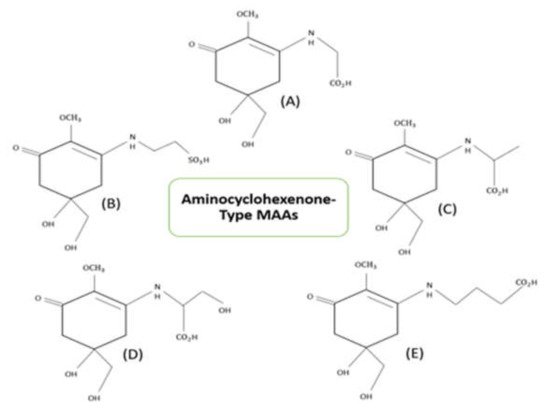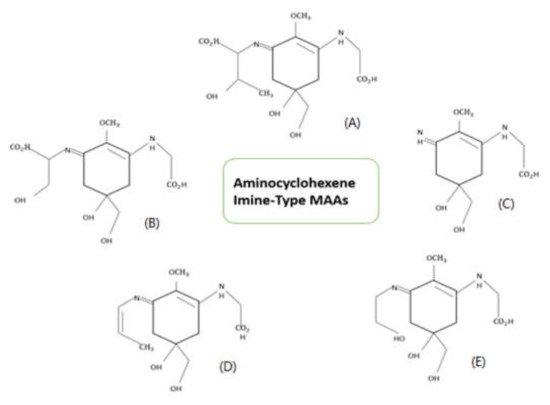Mycosporine-like amino acids (MAAs), are secondary metabolites, first reported in 1960 and found to be associated with the light-stimulated sporulation in terrestrial fungi. MAAs are nitrogenous, low molecular weight, water soluble compounds, which are highly stable with cyclohexenone or cycloheximine rings to store the free radicals. Microalgae are considered as a good source of different kinds of MAAs, which in turn, has its own applications in various industries due to its UV absorbing, anti-oxidant and therapeutic properties. Microalgae can be easily cultivated and requires a short generation time, which makes them environment friendly source of biomolecules such as mycosporine-like amino acids. Modifying the cultural conditions along with manipulation of genes associated with mycosporine-like amino acids biosynthesis can help to enhance MAAs synthesis and, in turn, can make microalgae suitable bio-refinery for large scale MAAs production.
1. Structure of Mycosporine-like Amino Acids (MAAs)
Mycosporine-like amino acids are multi-beneficial compounds with molecular weight of less than 1.2 kDa
[1][3]. These molecules are highly water-soluble when compared to other secondary metabolites like scytonemin. The zwitterionic form of MAAs absorbs UV radiation, with the utmost absorbance at 310–365 nm. The first finding of mycosporines P310 was done in terrestrial fungi
Stereum hirsutum. The structure 1,2-methoxy-3-bis (hydroxymethyl) methylamino-5-hydroxy-5-hydroxymethyl-2-cyclohexen-1-one has been credited to mycosporine P310. Mycosporines were earlier depicted as differentiation or reproduction markers in fungal spores
[2][37]. Nowadays, these compounds are well known for their multiple cellular functions such as osmoprotectant
[3][10] and antioxidant
[4][38] activities. Based on their core chromatophore structure, MAAs are classified into two types viz., cyclohexenone ring showing oxo-MAAs and cyclohexene imine ring showing imino-MAAs. Examples of oxo-MAAs are mycosporine-glycine and mycosporine-taurine, while imino-MAAs are shinorine, palythine, asterina-330, palythene, etc.
[5][39].
Figure 12 and
Figure 23 describes the structures of prominent MAAs belonging to these classes found in microalgae.
Figure 12. Structures of prominent Aminocyclohexenone-type MAAs (Monosubstituted MAAs) found in microalgae. Their absorption maximum in nanometer (nm) is given in brackets. (
A) Mycosporine-Glycine (310 nm), (
B) Mycosporine-Taurine (309 nm), (
C) Mycosporine-Alanine (310 nm) (
D) Mycosporine-Serine (310 nm), (
E) Mycosporine-γ-Aminobutyric Acid (310 nm)
[1][6][7][3,27,40].
Figure 23. Structures of prominent Aminocyclohexene Imine-Type MAAs (Disubstituted MAAs) found in microalgae. Their absorption maximum in nanometer (nm) is given in brackets. (
A) Porphyra-334 (334 nm), (
B) Shinorine (333–334 nm), (
C) Palythine (320 nm), (
D) Usujirene (357 nm) (
E) Asterina-330 (330 nm)
[1][6][8][3,27,41].
MAAs are denoted as microbial sunscreens which are natural and well known for its UV absorbing property
[9][10][11][12][13][42,43,44,45,46]. UV rays are of three types UVA, UVB and UVC; among these UVA is absorbed strongly by MAAs. MAAs play supplementary roles, they can scavenge toxic oxygen radicals, in certain organisms. They are compatible solutes, which are designed to protect against thermal, desiccation and salt stress. They also serve as an intracellular nitrogen reservoir in some of the organisms
[14][11].
MAAs are mostly seen as solutes in cytosolic space, but in some terrestrial cyanobacterium, it was also reported as derivatives of mycosporines linked to amino acids and oligosaccharides secreted by their cells
[15][47]. MAAs levels inside the cells are affected by certain environmental factors like nutrient availability, stress conditions, and UV. PAR (Photosynthetically Active Radiation), UVA and UVB radiation equally influences the production of MAAs inside the cells
[16][48]. MAAs are promising metabolites in biotechnology because of their antioxidant properties and photostability over a wide range of temperatures and pH. They can protect humans from immune suppression and photo-oxidative damage. MAAs are highly stable at room temperature and at a pH range of 4.5–8.5. However, the stability of the compound decreases with an increase in temperature and pH. It has been observed that degradation of MAAs can happen much faster in alkaline conditions
[17][49].
MAAs are highly stable because of their zwitterionic form, which is stabilized by resonance between equivalent structures and also due to its hydrogen bonds. Most of the MAAs have hydrogen bonded 3D structures with more than 12 bonds
[18][50]. Extracellular oligosaccharides linked MAAs (OS-MAAs) have core ring structures linked to oligosaccharide side chains. Polysaccharides and external proteins are strongly attached to this side chain, which are present in some cyanobacterial species
[15][19][47,51]. Based on the presence of attached protein, MAAs can be grouped into two forms, which are soluble non-protein associated MAAs present in algal invertebrate symbionts and protein associated MAAs present in symbiotic metazoans
[10][43].
2. Properties of Mycosporine-like Amino Acids (MAAs)
Mycosporines, have a common cyclohexenone ring system, which shares equal spectral characteristics and absorption maxima irrespective of their different molecular structures
[13][46]. They are dependent on temperature and pH along with solvent nature rather than moieties linked to the ring structure. In the case of zwitterion, protonation occurs and delocalization of electrons can be prevented by ion pair electrons in nitrogen
[20][52].
Further, the photoprotective role of MAAs is based on photostability, lack of fluorescence and radical production
[21][53]. Anoxic conditions can increase the photostability. Mycosporine-like amino acids does not undergo any degradation under anaerobic conditions when treated with methanolic solutions. The high degree of photostability also depends on the acidity of the medium, which was proved when structurally related keto-enolic gadusol was treated in an aqueous solution for photostability studies
[22][54].
The mycosporine-glycine is not stable under aerobic conditions and they have to be converted to methyl esters. In acidic media many MAAs are converted to methyl esters with HCl methanol treatment
[23][55]. Temperature can also affect the stability of MAAs. However, even at high temperatures absorption properties of the compounds are not affected
[24][56].


